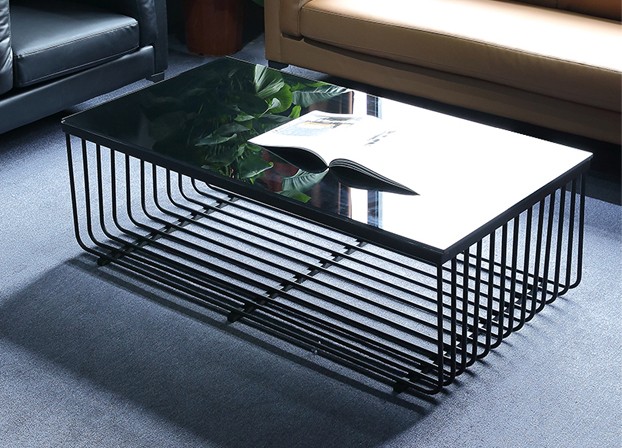Metal coffee table frames are a common feature in modern interior design, valued for their strength, durability, and sleek aesthetic. Among the most critical pieces of equipment involved in this production process are the laser pipe cutting machine, the pipe bending machine, and the laser welding robot. These machines help ensure the structural integrity, visual appeal, and production speed of the final product.

1. Laser pipe Cutting Machine: The Foundation of Precision
The first major step in the production process is cutting the metal pipes to the required dimensions. This task is handled by a laser pipe cutting machine, an advanced piece of equipment that combines speed and accuracy to deliver perfectly cut pieces of tubing for the frame.
How It Works
Laser pipe cutting machines use a high-powered laser beam to slice through metal pipes with incredible precision. The process is guided by CNC (Computer Numerical Control), which allows for complex geometries, cutouts, and even engravings to be made directly onto the metal pipe before any further processing.
Key Functions and Advantages
Accuracy and Consistency: The laser pipe cutting machine ensures that each piece is cut to exact specifications. This reduces material waste and ensures a tight fit during assembly and welding.
Speed and Automation: Modern laser pipe cutting machines can automatically load, cut, and unload pipes, significantly reducing the time required for the initial processing stage. This is crucial in mass production settings.
Material Versatility: These laser pipe cutting machines can work with a variety of metals commonly used in coffee table frames, including mild steel, stainless steel, and aluminum.
Role in Coffee Table Frame Production
Each segment of the frame—legs, supports, and connectors—must be cut precisely to ensure stability and symmetry. The laser pipe cutting machine ensures that all parts are dimensionally perfect and ready for the next stage: bending.
2. Pipe Bending Machine: Shaping the Frame
After cutting, many parts of the coffee table frame must be bent into specific angles or curves to fit the design. This shaping is performed by a pipe bending machine, which transforms straight metal pipes into complex, load-bearing geometries without compromising the material’s strength.
How It Works
Pipe bending machines operate using various techniques, such as rotary draw bending, compression bending, or roll bending, depending on the machine type and desired shape. CNC-controlled pipe bending machines are commonly used for consistent, repeatable bends across large production runs.
Key Functions and Advantages
Controlled Bending: CNC pipe bending machines can create precise angles and curves with minimal deformation or wrinkling of the material. This is essential for maintaining the aesthetics and strength of the frame.
Time Efficiency: Pipe bending machines can complete complex bending tasks in seconds, dramatically reducing labor costs and manual effort compared to traditional methods.

3. Laser Welding Robot: Joining with Precision
Once all the components are cut and bent to shape, the next stage is assembly—joining the parts together to form the complete frame. This is where the laser welding robot comes into play. It performs the essential task of fusing the individual metal parts into a single, cohesive structure.
How It Works
Laser welding robots utilize a focused laser beam to melt and fuse metal at the joint. The robot arm is controlled by a computer program that guides it along pre-set paths, ensuring precise and repeatable welds.
Key Functions and Advantages
High Precision: The laser welding process produces narrow, deep welds with minimal heat-affected zones (HAZ), resulting in strong joints with less risk of distortion.
Automation and Repeatability: Laser welding robits can repeat complex weld patterns across thousands of units with no drop in quality, which is essential for high-volume production.
Clean and Aesthetic Welds: Unlike traditional arc welding, laser welding robot produces clean seams with little to no spatter, reducing the need for post-weld grinding or polishing.
Strength and Durability: The strength of laser welding robots ensures that the coffee table frame can withstand regular use and support significant weight over time.
Reduced Human Error: Laser welding robots eliminate inconsistencies caused by fatigue or manual mistakes, especially in precision-dependent designs.
Role in Coffee Table Frame Production
The laser welding robot not only ensures strong structural joints but also maintains the aesthetic quality of the final product.
Conclusion: Integrating Technology for Superior Products
The production of metal coffee table frames is a complex process that demands precision, efficiency, and high-quality finishes. By integrating advanced technologies like the laser pipe cutting machine, pipe bending machine, and laser welding robot, manufacturers can meet these demands while reducing production time and costs.
Each machine plays a distinct and essential role:
Laser pipe cutting machines provide accurate, clean-cut components ready for assembly.
Pipe bending machines shape those components into design-specific curves and angles without compromising integrity.
Laser welding robots join them with strength and consistency, ensuring a durable and visually appealing product.
In an increasingly competitive furniture market, leveraging such automation technologies is no longer optional—it’s a necessity for producing high-quality, cost-effective, and aesthetically superior products.

